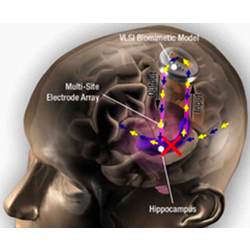
Researchers have found a way to boost memory in the human brain by digitally recording memories through tiny electrodes, then reintroducing those memories back into the brain at a later time.
"This is the first time scientists have been able to identify a patient's own brain-cell code or pattern for memory and, in essence, 'write in' that code to make existing memory work better," says Robert Hampson, a professor of physiology and pharmacology at the Wake Forest School of Medicine of Wake Forest University in North Carolina, and a lead researcher on the study.
Using this method, researchers at Wake Forest, working with colleagues at the University of Southern California (USC), were able to boost memory by 35% in an initial test of their system, before boosting memory again by 37% in a second test.
"Memory is a complex process, and we are quite pleased with the success of the current system to improve human memory," says Sam A. Deadwyler, a professor of physiology and pharmacology at Wake Forest and a lead researcher on the study. "It is clear that we need to continue the evolution of the techniques utilized in our prosthetic system, and to extend our understanding of how to most effectively apply these principles for restoring memory function."
The researchers say they captured the memories by inserting tiny electrodes into the brain through holes drilled into the skull, and then 'listening' to individual neurons as they created memories.
The study's subjects were epilepsy patients, people whose brains were already under analysis by doctors looking to find treatments for their seizures.
Researchers say each time a memory is generated in the brain, neurons send out telegraphic-like signals, a series of beeps and similar sounds. They captured those signals from the patients they studied with the tiny electrodes, recording them digitally on a computer.
In practice, each neuron involved in the creation of a memory only captures a tiny facet of a memory, according to biomedical engineer and neuroscientist Theodore Berger, director of the Center for Neural Engineering at USC. When sensing a human face, he explains, one neuron may transmit telegraphic-like signals about hair color, another may sense cheekbones, and a third may send signals about a crooked smile. All that data is captured by the electrodes, then run through software developed at USC that makes sense of all the telegraphic-like signals and renders the memory digitally, Berger says.
The precise number of neurons needed to store a memory is unknown, but the telegraphic-like signals from the approximately 40 neurons researchers were able to listen to were ultimately enough to capture a memory and boost its recall significantly.
Moreover, the researchers found, reintroducing a memory into the human brain is as simple as reversing the process: the digitally recorded signals are sent back down the electrodes into the precise location where they were first recorded, where they stimulate the same neurons that generated the memory in the first place.
"We think one of the reasons we saw improved memory was because we were able to reintroduce the recorded memories back to the same location in the brain where they were first generated," Berger says.
Still, Berger says, researchers need to find a way around a number of challenges to bring back even better memory recall. "It's not always easy; there's a lot of noise going on the brain" as a memory is being formed, Berger says.
Also, when reintroducing memories back in the brain, some neurons not involved in the original creation of a memory can be inadvertently fired, potentially muddling the memory.
In the long term, the researchers hope their work, funded by the U.S. Defense Advanced Project Agency (DARPA), can one day become a product that can improve the memories of millions of people afflicted with Alzheimer's disease and similar memory maladies.
Says Berger, "We're really not that far away from a commercial product." The research team, he says, is confident such a memory device can be assembled from readily available electronics. Tiny hardware hardwired into the brain could rest discretely near the ear, where Berger says it could wirelessly transmit the signals of neurons firing to a computerized device worn on the belt.
"Most of the time that we'd need to get a product to market would involve getting approval from the FDA (U.S. Food and Drug Administration)," Berger says.
Berger sees real promise for the technology, provided he and his team can deliver much higher memory recall, as well as verifiable safety levels (crucial for a device to be wired to the brain). He sees the potential market for the device as anyone having significant problems with memory, or who knows they facing that fate (like people in the initial stages of Alzheimer's disease).
Besides aiding memory, any commercial device that arises from the research could also change the very nature of what it is to be human, according to microbiologist Brian Hanley, founder and chief scientist of Butterfly Sciences, a company created to develop gene therapies for HIV and aging.
With millions of memory recording devices in the hands of everyday people, it is simple to envision a scenario in which people begin sharing their memories with one another, and possibly sharing memories from other species as well, such as dolphins, eagles, or even bacteria. "As that occurs, it can fray the edges of who and what we are," Hanley says.
Joe Dysart is an Internet speaker and business consultant based in Manhattan, NY, USA.



Join the Discussion (0)
Become a Member or Sign In to Post a Comment